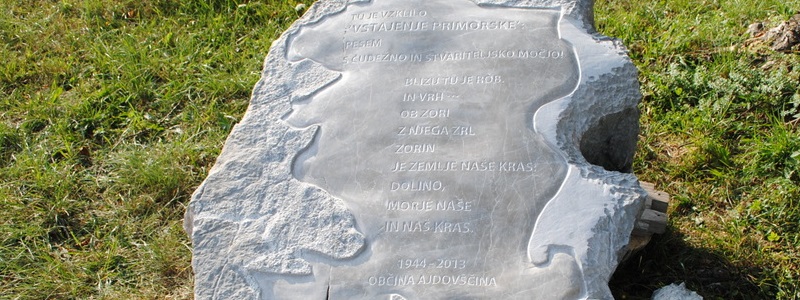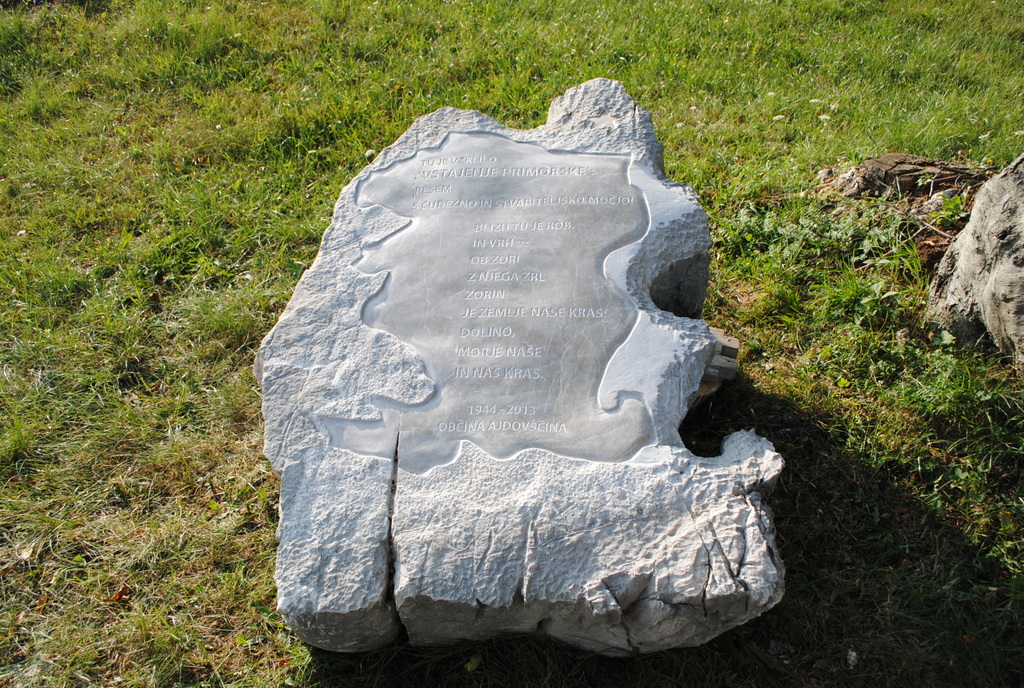The monument dedicated to the anthem of the Slovenian Littoral, Vstajenje Primorske (The Rise of the Littoral), was erected in 2013 in commemoration of the 70th anniversary of its genesis. The memorial enjoys the spectacular view that inspired the author of the lyrics, Lev Svetek-Zorin. In 1944, the day after he arrived at the frontier guardhouse, Svetek climbed a nearby mountain which has an expansive panoramic view of the Vipava Valley and further across the Karst plateau, with the Gulf of Trieste in the background. Overwhelmed by the experience, Svetek expressed his sentiments in a patriotic song, Vstajenje Primorske, adapted and set to music by composer Rado Simoniti.
The stone memorial was built on the initiative of Lucijan Trošt and Franc Černigoj, and bears an inscription contributed by the latter, “This is where the Rise of the Littoral germinated: a song possessing magical and creative powers! Nearby, stand the brow and top of the hill… dawn was breaking over the vale when Zorin gazed across the beauty of our native soil, the valley, our sea and our Karst.” The stone memorial, which stands on land owned by Ivanka and Mirko Hladnik, was designed by artist Silva Karim, and made by stonecutters of the Society MOST, operating under the aegis of the Third Age University in Ajdovščina.
The artist shared her thoughts on the creative work, “The monument honouring the famed Littoral song was somehow made ‘in cooperation with nature’, to borrow the slogan of one of the former prides of Ajdovščina (TN: Slovenia’s top fruit juice manufacturer, Fructal). In short, I was presented with a weathered stone found somewhere on the slopes of Križna gora. Exposed to the elements for millions of years, the stone was furrowed by water, chiselled by frost, ravaged by storms, scorched by the sun…
Such works of art are called found objects or readymades. The term describes art crafted from undisguised but often modified objects, mostly found ones, which convey the artistic message envisioned and given to them by the artist.
Our stone communicated a certain idea even before being touched by the chisels. In its coarse structure, a certain phallic uprightness and at the same time heftiness, the force of gravity that firmly pulled it to the ground, the stone appeared so primordial, as primal as love and the stubborn perseverance of the Littoral people. Stone: there’s no better material to keep alive the memory of the origins of the song Vstajenje Primorske.”
Rado Simoniti
The enduring legacy of Rado Simoniti (1914–1981) renders the prolific composer and conductor, popularly known as “the songsmith of Goriška brda”, one of the leading figures of Slovenian music tradition. His impressive output includes choral music, lieder, cantatas, opera Partizanka Ana (Partisan Ana), and the popular song Vstajenje Primorske (The Rise of the Littoral), which has acquired the status of a folk song and is the unofficial anthem of the Slovenian Littoral. Committed to asserting national identity, he formed the Srečko Kosovel Partisan Choir, which toured Slovenia and Europe with Simoniti – the choir’s influential choirmaster and composer of numerous Slovenian partisan songs – at the helm. Permeated with a sense of folk melodiousness, Simoniti’s extensive body of choral music includes around 300 works, of which 200 are original compositions and 100 adaptations of folk songs.
Siminotti’s homelife and school were imbued with choral music, as he sang in the choir of the Collegium Marianum Boys’ School in Ljubljana and was tutored by his father Anton Simoniti, organist and choirmaster of several choirs in the Goriška region. Simoniti attended the Secondary School of the Conservatory of Music in Ljubljana and studied organ with Stanko Premrl. Having completed his secondary education, Simoniti taught at the Municipal Music School in Split, Croatia, between 1937 and 1939, and conducted the Choir of the Tomislav Music Society. The new milieu sparked his interest in the folk melodies of the wider historical region of Dalmatia.
Having returned to Ljubljana, he pursued and advanced his musical career as a choral director. He was choirmaster at the Slovenian National Theatre (1939–1943) and at the same time studied conducting under Danilo Švara at the newly-established Academy of Music in Ljubljana. At the Academy, he also studied composition under the tutelage of two of the foremost Slovenian music authorities, composers Lucijan Marija Škerjanc and Marijan Lipovšek. In 1939, Simoniti was appointed Ljubljana Opera’s first chorus master, and between 1948 and 1958 served as the conductor of the Slovenian Philharmonic Choir. He was the choirmaster of a number of prominent choirs, including the Emil Adamič Teachers’ Choir, the France Marolt Academic Choir and the Krakovo-Trnovo Choir.
After graduating in conducting with a production of Verdi’s Traviata, Simoniti also built a career in opera. The influence of numerous stagings of the standard Italian verismo repertoire under his baton can be easily traced in Simoniti’s composing style, in which the flowing melody of verismo style formed the core of his musical idiom.
He dedicated himself to writing partisan songs and folk song adaptations in 1943, the year he joined the cultural group of the 20th Commando Brigade Ljubljana, the shock troops with whom he carried out raids on the Island of Vis and in southern Italy. It was there in 1944 that he completed Naša pesem (Our Song), his first collection of national and international songs of resistance. Thereupon, Simoniti formed a partisan choir named after the poet Srečko Kosovel, which performed partisan songs in a range of venues, from Dalmatia to the Slovenian Primorska (Littoral) and Štajerska (Styria) regions. The choir also toured France and Belgium.
Simoniti’s vocal music – the first Slovenian partisan opera, lieder and choral pieces – is recognised as his chef-d’oeuvre. His output of 600 works also includes two cantatas: Kolednica mladinskih brigad (The Carol of Youth Brigades) – a musical setting of a poem by Oton Župančič – and Na kozlovem robu (At Kozlov rob), based on lyrics by Alojz Gradnik. Displaying all the distinctive qualities of Simoniti’s musical texture (most notably the smooth cantabile style of bel canto and tendency towards the verismo style), the opera Partizanka Ana (Partisan Ana) features a representative tragic heroine who does not lament her sad fate, but voices hope for a bright future in socialist realism. Reflecting influences of romantic lieder, Simoniti’s partisan songs for solo voice and piano were musical settings of poems by Slovenian authors, particularly Matej Bor, Smiljan Samec and Srečko Kosovel, and enjoyed great popularity. Many of his lieder, notable examples include Pomlad, Še veš …, Na Krasu, Po dežju, Sanjala si o vrtnicah rdečih and Ples v rdečem (Spring, Do You Remember…, At the Karst, After the Rain, You Dreamt of Red Roses, and Dancing in Red) have approached the status of folk songs, as have some of his choral pieces.
Particularly noteworthy among his choral output are the compositions Tito and Pesem o Titu (Song about Tito) for large ensembles, Starka za vasjo (Old Woman outside the Village) for mixed choir, Čriček na vrtu (Cricket in the Garden) for female choir, and the male choir pieces Le vkup, le vkup, uboga gmajna (Come Together, Come Together, You Poor Commons) and Na oknu glej obrazek bled (Behold a Pale Face in the Window).
Maia Juvanc

